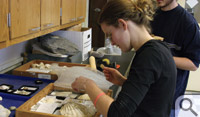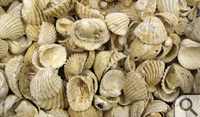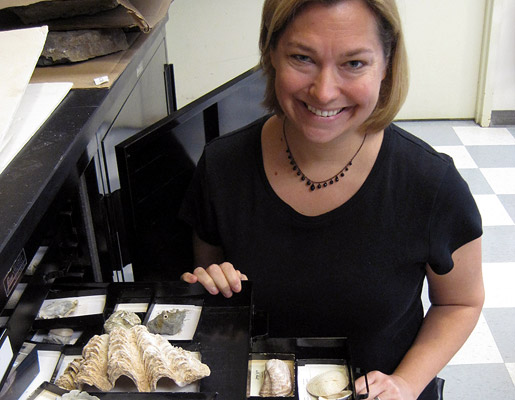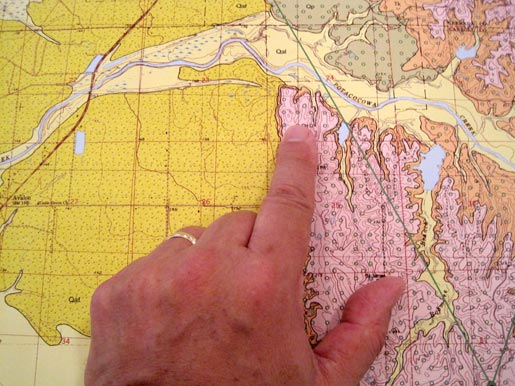One size (or shape) isn’t the fittest
When extinction looms, diversity rules. At least for clams.
When it comes to the hard work of evolutionary paleontology, you can’t beat the humble clam. Actually, you need a very large stack of humble clam fossils, because when you’re tracing the mechanisms that drive evolution, you need a lot of individuals.
 Sarah Kolbe ’06 believes she looked at around 10,000 clam
fossils at William & Mary, part of a senior Honors project under the
mentorship of paleontologist Rowan Lockwood, an associate professor in the Department of Geology. The
two continued to collaborate after Kolbe graduated and Kolbe’s Honors project
grew into a major
paper (pdf) published in the prestigious journal Paleobiology.
Sarah Kolbe ’06 believes she looked at around 10,000 clam
fossils at William & Mary, part of a senior Honors project under the
mentorship of paleontologist Rowan Lockwood, an associate professor in the Department of Geology. The
two continued to collaborate after Kolbe graduated and Kolbe’s Honors project
grew into a major
paper (pdf) published in the prestigious journal Paleobiology.
The paper addresses an important evolutionary question: Why do some species survive extinction events and other species don’t? Lockwood and Kolbe looked at species on either side of the two-million-year-old clam-killing upheaval known as the Plio-Pleistocene extinction.
Survival of the most variable
They found when it comes to surviving the stresses of major extinction events, one size—or shape—definitely does not fit all.
“It didn’t look like there was any one type of shape that was best,” Kolbe said, “but a species with more morphological variation—one that had individuals with different kinds of shapes—tended to be more likely to survive.”
The researchers concentrated their study on 14 pairs of clam species. One species of each pair died out during the Plio-Pleistocene extinction. The extinct species was matched up with a close relative that survives to this day.
“We looked at a victim species and a survivor species,” Lockwood explains. She acknowledges that differences among clams of different species are pretty subtle.
“When I first started working on them I couldn’t tell one clam from another,” she said. “But there are differences in size and thickness, differences in the shape of the teeth in the hinge. All of these things—once you stare at them for a little while—start to become more obvious.”
 Once they had their 14 pairs of target species identified,
Lockwood and Kolbe started looking at the individuals of each species.
Supported by a Chappell Fellowship from William & Mary’s Roy R. Charles
Center during her senior year, Kolbe collected clam fossils from a Florida
quarry. Lockwood describes it as “basically 3-5 meters deep, and the entire
thing covers probably two square miles and it’s jam-packed with shell.”
Once they had their 14 pairs of target species identified,
Lockwood and Kolbe started looking at the individuals of each species.
Supported by a Chappell Fellowship from William & Mary’s Roy R. Charles
Center during her senior year, Kolbe collected clam fossils from a Florida
quarry. Lockwood describes it as “basically 3-5 meters deep, and the entire
thing covers probably two square miles and it’s jam-packed with shell.”
Kolbe did all the measuring and tallying—around 100 clams of each target species—at William & Mary. After graduation, Kolbe did a Fulbright Fellowship at a Danish geological museum, then entered a paleontology Ph.D. program at the University of Cincinnati; she expects to defend her dissertation in the summer.
A number of possible explanations
She was busy, but Kolbe found time to work with Lockwood on her clam project. After all the numbers were sliced and diced, it was clear that when extinction looms, diversity rules—at least among the clams of two million years ago. There could be a combination of reasons to explain the survivorship rate of species with greater morphological variability, compared to species whose individuals are more uniform.
“Having that variety of forms—fat, thin, more elongate or not—might make you more able to deal with environmental change during an extinction event,” Kolbe explained. “Some of those forms might be more able to succeed in the new environment than others.”
Lockwood suggests that the morphological variability apparent in the fossilized shells might mean that that the survivor species have more variability in their DNA.
“More genetic variation makes you much more bombproof when things like climate change or overharvesting or something like that happens,” Lockwood said. “Sarah’s paper is the first one to look at this quantitatively in the fossil record.”
Lockwood says “Sarah’s paper,” because her former student is the first author. Gene Hunt of the Smithsonian Institution is also a contributor. The paper, “Does morphological variation buffer against extinction? A test using veneroid bivalves from the Plio-Pleistocene of Florida,” is generating a lot of buzz in evolutionary circles. One reviewer wrote, “This paper is (to my knowledge) the first to empirically assess the relationship between intraspecific variation and survival across an extinction event. It stands to make a significant contribution to the evolutionary literature.”
The edibility question
The fossils in the study are close relatives of littlenecks, cherrystones and other common food clams. The collaborators are divided on the edibility question. Lockwood says, “It never hurts to be able to eat your study organism,” while Kolbe will stick with the fossils.
“I think they’re kinda rubbery,” she says. “I’m not too into them.” ![]()
This story appeared in
the winter, 2011 issue of the William & Mary Alumni
Magazine.

















